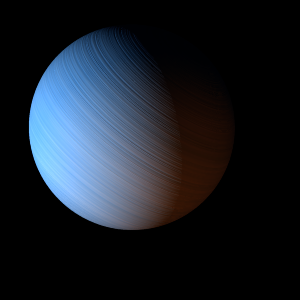|
|
Space Astro
|
Info for exoplanet "Ioteus"
| Scientific (actual) data |
|---|
| Name | Kepler-1658 b |
| Planet status | Confirmed |
| Planet mass | 5.88 |
| Radius | 1.07 |
| Orbital period | 3.84937 |
| Semi major axis | 0.0544 |
| Orbit eccentricity | 0.0628 |
| Inclination | 76.52 |
| Discovered | 2019 |
| Updated | 2022-12-20 |
| Omega | 352.27 |
| Tconj | 2455010 |
| Impact parameter | 0.9471 |
| K | 580.83 |
| Publication | Published in a refereed paper |
| Detection type | Primary Transit |
| Mass measurement type | Radial Velocity |
| Radius measurement type | Primary Transit |
| Alternate names | 2MASS J19372557+3856505 b, K00004.01, KIC 3861595 b, TYC 3135-652-1 b, WISE J193725.57+385650.4 b, KOI-4 |
| Star name | Kepler-1658 |
| Right ascension | 294.36° |
| Declination | 38.95° |
| Mag v | 11 |
| Mag j | 10.475 |
| Mag h | 10.266 |
| Star distance | 806.07 |
| Star metallicity | -0.18 |
| Star mass | 1.45 |
| Star radius | 2.89 |
| Star temperature | 6216 |
| Star alternate names | 2MASS J19372557+3856505, KIC 3861595, KOI-4, TYC 3135-652-1, WISE J193725.57+385650.4 |
| Wikipedia article | Kepler-1658 b |
Back
| |
| Fictional info (?) |
|---|
| Suggested name | Ioteus |
| Planet type | Large hot gas giant |
| It has the densest atmosphere of the two large hot gas giants, consisting partly of formaldehyde. . It may have had 2H2O oceans in the past, but these would have vaporized as the temperature rose due to a runaway greenhouse effect.
A prominent result is the "great black spot", a giant storm that is known to have existed for centuries since it was first observed by radar. |
| Atmosphere | Formaldehyde | 93% |
| Nitric oxide | 5.9% |
| 2H2O | 0.28% |
| Ethane | 2.3E-5% |
| Atmospheric pressure | 0.01 bar |
 |
| No known satellites |
| Google search for Ioteus |
|
Website by Joachim Michaelis
|
|
|
|